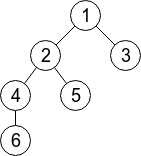A tree is an undirected connected graph without cycles. The distance between two vertices is the number of edges in a simple path between them.
Limak is a little polar bear. He lives in a tree that consists of n vertices, numbered 1 through n.
Limak recently learned how to jump. He can jump from a vertex to any vertex within distance at most k.
For a pair of vertices (s, t) we define f(s, t) as the minimum number of jumps Limak needs to get from s to t. Your task is to find the sum of f(s, t) over all pairs of vertices (s, t) such that s < t.
The first line of the input contains two integers n and k (2 ≤ n ≤ 200 000, 1 ≤ k ≤ 5) — the number of vertices in the tree and the maximum allowed jump distance respectively.
The next n - 1 lines describe edges in the tree. The i-th of those lines contains two integers ai and bi (1 ≤ ai, bi ≤ n) — the indices on vertices connected with i-th edge.
It's guaranteed that the given edges form a tree.
Print one integer, denoting the sum of f(s, t) over all pairs of vertices (s, t) such that s < t.
13 3
1 2
3 2
4 2
5 2
3 6
10 6
6 7
6 13
5 8
5 9
9 11
11 12
114
In the first sample, the given tree has 6 vertices and it's displayed on the drawing below. Limak can jump to any vertex within distance at most 2. For example, from the vertex 5 he can jump to any of vertices: 1, 2 and 4 (well, he can also jump to the vertex 5 itself).

There are  pairs of vertices (s, t) such that s < t. For 5 of those pairs Limak would need two jumps: (1, 6), (3, 4), (3, 5), (3, 6), (5, 6). For other 10 pairs one jump is enough. So, the answer is 5·2 + 10·1 = 20.
pairs of vertices (s, t) such that s < t. For 5 of those pairs Limak would need two jumps: (1, 6), (3, 4), (3, 5), (3, 6), (5, 6). For other 10 pairs one jump is enough. So, the answer is 5·2 + 10·1 = 20.
In the third sample, Limak can jump between every two vertices directly. There are 3 pairs of vertices (s < t), so the answer is 3·1 = 3.
题意:
给你一棵树,求出所有f(S,T)的和;
f(S,T)表示,ST在树上的距离除k取上整
题解:
k最大只有5
设定DP[i][j]表示已i节点为根的子树上到i节点的距离%k=j的节点数,转移很简单
fs[i][j]表示已i节点为根的子树上到i节点的距离%k=j的除k的大小
细节需要处理好
#include<bits/stdc++.h> using namespace std; #pragma comment(linker, "/STACK:102400000,102400000") #define ls i<<1 #define rs ls | 1 #define mid ((ll+rr)>>1) #define pii pair<int,int> #define MP make_pair typedef long long LL; const long long INF = 1e18+1LL; const double Pi = acos(-1.0); const int N = 5e5+10, M = 1e3+20, mod = 1e9+7, inf = 2e9; vector<int > G[N]; LL dp[N][10],fs[N][10]; LL ans = 0; int n,k,a,b; void dfs(int u,int f) { dp[u][0] = 1; for(int i = 0; i < G[u].size(); ++i) { int to = G[u][i]; if(to == f) continue; dfs(to,u); for(int j = 0; j <= k; ++j) { for(int h = 0; h <= k; ++h) { if(!dp[u][j]||!dp[to][h]) continue; LL tmp = j+h+1; if(tmp%k) tmp = tmp/k+1; else tmp = tmp/k; ans += tmp*dp[to][h]*dp[u][j]+fs[u][j]*dp[to][h]+fs[to][h]*dp[u][j]; } } for(int j = 1; j <= k; ++j) dp[u][j] += dp[to][j-1],fs[u][j] += fs[to][j-1]; dp[u][1] += dp[to][k];fs[u][1] += fs[to][k]+dp[to][k]; } } int main() { scanf("%d%d",&n,&k); for(int i = 1; i < n; ++i) { scanf("%d%d",&a,&b); G[a].push_back(b); G[b].push_back(a); } dfs(1,0); cout<<ans<<endl; return 0; }